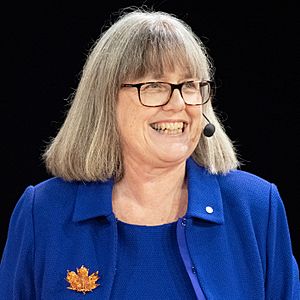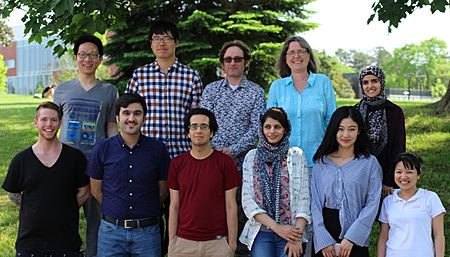Donna Strickland facts for kids
Quick facts for kids
Donna Strickland
|
|
|---|---|

Strickland in 2018
|
|
| Born |
Donna Theo Strickland
27 May 1959 Guelph, Ontario, Canada
|
| Alma mater |
|
| Spouse(s) | Doug Dykaar |
| Awards | Nobel Prize (2018) |
| Scientific career | |
| Institutions |
|
| Thesis | Development of an Ultra-Bright Laser and an Application to Multi-photon Ionization (1988) |
| Doctoral advisor | Gérard Mourou |
Donna Theo Strickland (born 27 May 1959) is a Canadian optical physicist and pioneer in the field of pulsed lasers. She was awarded the Nobel Prize in Physics in 2018, together with Gérard Mourou, for the practical implementation of chirped pulse amplification. She is a professor at the University of Waterloo in Ontario, Canada.
She served as fellow, vice president, and president of Optica (formerly OSA), and is currently chair of its Presidential Advisory Committee. In 2018, she was listed as one of BBC's 100 Women. She has gone on to have the Natural Sciences and Engineering Research Council of Canada Prize being set in her name.
Contents
Early life and education
Strickland was born on 27 May 1959, in Guelph, Ontario, Canada to Edith J. (née Ranney), an English teacher, and Lloyd Strickland, an electrical engineer. After graduating from Guelph Collegiate Vocational Institute, she decided to attend McMaster University because its engineering physics program included lasers and electro-optics, areas of particular interest to her. At McMaster, she was one of three women in a class of twenty-five. Strickland graduated with a Bachelor of Engineering degree in engineering physics in 1981.
Strickland studied for her graduate degree in The Institute of Optics, receiving a Doctor of Philosophy degree from the University of Rochester in 1989. She conducted her doctoral research at the associated Laboratory for Laser Energetics, supervised by Gérard Mourou. Strickland and Mourou worked to develop an experimental setup that could raise the peak power of laser pulses, to overcome a limitation, that when the maximal intensity of laser pulses reached gigawatts per square centimetre, self-focusing of the pulses severely damaged the amplifying part of the laser. Their 1985 technique of chirped pulse amplification stretched out each laser pulse both spectrally and in time before amplifying it, then compressed each pulse back to its original duration, generating ultrashort optical pulses of terawatt to petawatt intensity. Using chirped pulse amplification allowed smaller high-power laser systems to be built on a typical laboratory optical table, as "table-top terawatt lasers". The work received the 2018 Nobel Prize in Physics.
Career and research

From 1988 to 1991, Strickland was a research associate at the National Research Council of Canada, where she worked with Paul Corkum in the Ultrafast Phenomena Section, which had the distinction at that time of having produced the most powerful short-pulse laser in the world. She worked in the laser division of Lawrence Livermore National Laboratory from 1991 to 1992 and joined the technical staff of Princeton University's Advanced Technology Center for Photonics and Opto-electronic Materials in 1992. She joined the University of Waterloo in 1997 as an assistant professor. She became the first full-time female professor in physics at the University of Waterloo. Strickland is currently a professor, leading an ultrafast laser group that develops high-intensity laser systems for nonlinear optics investigations. She has described herself as a "laser jock":
I think it's because we thought we were good with our hands. As an experimentalist, you need to understand the physics, but you also need to be able to actually make something work, and the lasers were very finicky in those days.
Strickland's recent work has focused on pushing the boundaries of ultrafast optical science to new wavelength ranges such as the mid-infrared and the ultraviolet, using techniques such as two-colour or multi-frequency methods, as well as Raman generation. She is also working on the role of high-power lasers in the microcrystalline lens of the human eye, during the process of micromachining of the eye lens to cure presbyopia.
Strickland became a fellow of Optica in 2008. She served as its vice president and president in 2011 and 2013 respectively, and was a topical editor of its journal Optics Letters from 2004 to 2010. She is currently the chair of Optica's Presidential Advisory Committee. She is a member of and previously served as a board member and Director of Academic Affairs for the Canadian Association of Physicists.
Awards and recognition
- 1998 – Alfred P. Sloan Research Fellowship
- 1999 – Premier's Research Excellence Award
- 2000 – Cottrell Scholars Award from Research Corporation
- 2008 – Fellow of The Optical Society
- 2018 – Nobel Prize in Physics
- 2019 – Golden Plate Award of the American Academy of Achievement presented by Awards Council member Frances Arnold
- 2019 – Companion of the Order of Canada
- 2019 – Honorary Fellow of The Canadian Academy of Engineering
- 2019 – Fellow of Royal Society of Canada
- 2020 – Member of the National Academy of Sciences
- 2020 – Elected a Fellow of the Royal Society (FRS)
- 2021 – Appointed to Pontifical Academy of Sciences
- 2022 – Awarded the insignia of Chevalier de la Légion d'honneur, the highest French distinction.
- 2022 – Awarded Honorary Member of Optica.
- 2022 – Awarded Joseph Carrier C.S.C. Science Medal from the University of Notre Dame.
- 2024 – Awarded an honorary doctor of science degree from the University of Alberta
Nobel Prize
On 2 October 2018, Strickland was awarded the Nobel Prize in Physics for her work on chirped pulse amplification with her doctoral adviser Gérard Mourou. Arthur Ashkin received the other half of the prize for unrelated work on optical tweezers. She became the third woman ever to be awarded the Nobel Prize in Physics, after Marie Curie in 1903 and Maria Goeppert Mayer in 1963.
Strickland and Mourou published their pioneering work "Compression of amplified chirped optical pulses" in 1985, while Strickland was still a doctoral student under Mourou. Their invention of chirped pulse amplification for lasers at the Laboratory for Laser Energetics in Rochester led to the development of the field of high-intensity ultrashort pulses of light beams. Because the ultrabrief and ultrasharp light beams are capable of making extremely precise cuts, the technique is used in laser micromachining, laser surgery, medicine, fundamental science studies, and other applications. It has enabled doctors to perform millions of corrective laser eye surgeries. She said that after developing the technique they knew it would be a significant discovery.
When she received the Nobel Prize, many commentators were surprised that she had not reached the rank of full professor. In response, Strickland said that she had "never applied" for a professorship; "it doesn't carry necessarily a pay raise ... I never filled out the paper work ... I do what I want to do and that wasn't worth doing." Strickland had not applied to be a full professor prior to her Nobel prize, but in October 2018, she told the BBC that she had subsequently applied and was promoted to full professorship at the University of Waterloo.
Order of Canada
Strickland was appointed as a Companion of the Order of Canada in 2019, one of Canada's highest civilian honours.
Personal life
Strickland is married to Douglas Dykaar, who received a doctorate in electrical engineering from the University of Rochester. They have two children: Hannah, a graduate student in astrophysics at the University of Toronto, and Adam, who is studying comedy at Humber College. Strickland is an active member of the United Church of Canada.
Professional Affiliations and Honors
Strickland became a fellow of Optica (formerly known as Optical Society of America) in 2008. She served as its vice president and president in 2011 and 2013 respectively, and was a topical editor of its journal Optics Letters from 2004 to 2010. She is currently the chair of Optica's Presidential Advisory Committee.
She is a former president of the Optical Society and director of Academic Affairs for the Canadian Association of Physicists.
See also
 In Spanish: Donna Strickland para niños
In Spanish: Donna Strickland para niños
- Criticism of Wikipedia#Notability of article topics
- List of University of Waterloo people
- Women in physics

